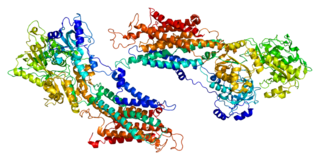
Phospholamban, also known as PLN or PLB, is a micropeptide protein that in humans is encoded by the PLN gene. Phospholamban is a 52-amino acid integral membrane protein that regulates the calcium (Ca2+) pump in cardiac muscle cells.

Leukotriene C4 synthase is an enzyme that in humans is encoded by the LTC4S gene.

Stromal interaction molecule 1 is a protein that in humans is encoded by the STIM1 gene. STIM1 has a single transmembrane domain, and is localized to the endoplasmic reticulum, and to a lesser extent to the plasma membrane.

DNA damage-inducible transcript 3, also known as C/EBP homologous protein (CHOP), is a pro-apoptotic transcription factor that is encoded by the DDIT3 gene. It is a member of the CCAAT/enhancer-binding protein (C/EBP) family of DNA-binding transcription factors. The protein functions as a dominant-negative inhibitor by forming heterodimers with other C/EBP members, preventing their DNA binding activity. The protein is implicated in adipogenesis and erythropoiesis and has an important role in the cell's stress response.

Sarcoplasmic/endoplasmic reticulum calcium ATPase 1 (SERCA1) also known as Calcium pump 1, is an enzyme that in humans is encoded by the ATP2A1 gene.

Autocrine motility factor receptor, isoform 2 is a protein that in humans is encoded by the AMFR gene.

Sarcoplasmic/endoplasmic reticulum calcium ATPase 3 is an enzyme that in humans is encoded by the ATP2A3 gene.

Homocysteine-responsive endoplasmic reticulum-resident ubiquitin-like domain member 1 protein is a protein that in humans is encoded by the HERPUD1 gene.

GPI transamidase component PIG-T is an enzyme that in humans is encoded by the PIGT gene.

Protein transport protein Sec31A is a protein that in humans is encoded by the SEC31A gene.

Protein CLN8 is a protein that in humans is encoded by the CLN8 gene.

Sarcolipin is a micropeptide protein that in humans is encoded by the SLN gene.

Phosphatidylinositol N-acetylglucosaminyltransferase subunit C is an enzyme that in humans is encoded by the PIGC gene.

Stromal interaction molecule 2 (STIM2) is a protein that in humans is encoded by the STIM2 gene.

Phosphatidylinositol N-acetylglucosaminyltransferase subunit H is an enzyme that in humans is encoded by the PIGH gene. The PIGH gene is located on the reverse strand of chromosome 14 in humans, and is neighbored by TMEM229B.

dolichyl-phosphate mannosyltransferase polypeptide 3, also known as DPM3, is a human gene.

Dolichol phosphate-mannose biosynthesis regulatory protein is a protein that in humans is encoded by the DPM2 gene.

Endoplasmic reticulum aminopeptidase 2 is an aminopeptidase in humans involved in antigen presentation. It is encoded by the ERAP2 gene.

Cadherin related family member 3 (CDHR3), also known as CDH28 or its abbreviation CDHR3, is a protein that in humans is encoded by the CDHR3 gene. The protein is predominately expressed in respiratory epithelium and the first notion of its clinical implications was from the discovery that genetic variation of CDHR3 is strongly associated to early severe asthma exacerbations in children. Subsequent studies have suggested that CDHR3 is a receptor for a subtype of rhinovirus.

ORMDL sphingolipid biosynthesis regulator 1 is a protein that in humans is encoded by the ORMDL1 gene.




















